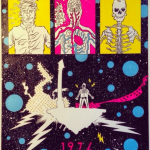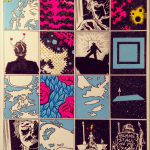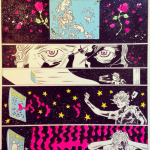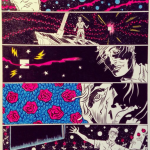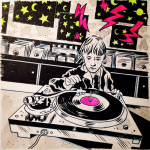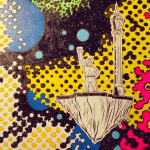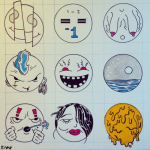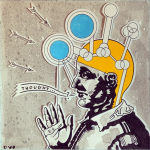Danny White is one of the most fascinating illustrators we’ve spoken to since the inception of our lovely little magazine. Self-taught as a child – Mama White says that Danny started drawing in the high chair as a baby – White latched onto comic books; a visual haven that quickly became a world of escape for him from the formidable responsibilities that come with losing a father at a young age, working illegally in a New York City factory, and eagerly trying to carve out some semblance of a future.
Although White could be seen hounding editors at comic conventions at age 15, and walking around Tompkins Square Park and hiding out in coffee shops to sketch and smoke cigarettes, the New York-based illustrator more wholeheartedly broke into the industry 8 years ago, when he decided to ditch a 12-year printing job and in turn harness a new sense of freedom within to pursue his illustrations and comics. Since, White creates entirely for himself and his devoted fan base. There’s no publisher telling him that he can’t create a black and white pin-up spattered with patches of hot pink. And if he wants to paint entire comic panels in acrylic paint and reproduce it in the same manner so that each book page looks handmade, than so be it!
Partially inspired by his gripping music obsession and entirely motivated by the incessant pains of gut-wrenching heartbreak, White’s most recent project “1976” has quickly mushroomed into a monumental project, chronicling, in retro-comic vivacity, all sorts of intriguing minutiae related to the intricate dimensions of love, music and understanding. White’s instinctive ability to create from his meticulously retained personal history and memories make each page of his ink-heavy comic illustrations deeply meaningful and told with great empathy and humor.
Having at this point finished 11 out of the 12 pages of “1976” that he plans on creating into book form, White took the time to talk with Amadeus about his most recent projects and his deeply personal artistic process.
Give us the D. White spiel. Tell us a little about your background and who you are.
My name is Danny but I’m a bit partial to just D. Born in Queens NY and grew up in a middle class suburban town called Farmingdale on Long Island. My dad was a New York City Fireman. He was a greaser in the early 60’s and when Vietnam happened, he signed up to get out of his house. He had this pretty horrific temper so I think the comics were an escape for me. Things made sense in that world; good versus evil and the right side usually won. In the real world that wasn’t always the case in my house. Luckily I had a very loving mother that nurtured my artistic side. She’s a special lady.
As I got older I dropped out of about four different colleges, although I did very much enjoy the journalism program I was enrolled in at one of those schools. After 12 years at printing job, some things changed in my life; I gave notice at my job and on lunch that day I found an ad on craigslist for a paint mixer/canvas stretcher in the city. No resume yet so I just wrote a short story about myself and within an hour I got a call from this woman named Esther. That moment just about changed my life…she did that for certain and remains a good friend and cheerleader for what I do. It ended up that the job was mixing the pallet for a very well known artist and it was about 20 bucks less than what I was making at the time but it was a leap I needed to make. Eight years later, I help run the place.
Along the way I started working at a coffee shop that has probably changed my life more than anything else. That entire experience allowed me to be young at a time when I most needed it and has been something of a fountain of youth since. So my life today is a 9-5 city job, Saturday serving job, and the rest of my time is spent drawing. Basically I put myself in a box and I’m trying to draw my way out of it.
When you catch yourself doodling, what do you usually find? Is there one image/idea that you find yourself subconsciously coming back to?
Besides some design elements like arrows and hearts not so much anymore. Years ago I would seemingly always start in the same place and end in the same place too, completely dissatisfied with my work and monumentally depressed! That’s why the guitar was always such a friend to me. My mistakes on it didn’t stay like they do on paper. But when I refocused my energy on art in the last few years, each new drawing really is an open book. It can be whatever I’ve been thinking about that day and it’s held up more by my own emotions than any lack of artistic skill or rut. Now as an adult if there are recurring aspects to my work it’s in the theme as opposed to the line or subject.
The dreadful and dangerous side of love and my need to understand it is something that keeps coming up…but ok…yeah when I’m spent emotionally I draw Batman. Always.
Tell us about the book project you’ve recently started working on, “1976”. How did the idea for “1976” evolve? How is this one different from other illustrated comics/narratives you’ve made?
1976 is my way of summing up everything that I’ve done over the last three years and trying to turn it into a loose narrative. I guess it’s that forever love of comics that makes me want the marker of this era for me to be a book. The book is about going back to the beginning…which is why it’s called 1976. That’s the year I was born, commercial punk rock came about a week after me and it’s all this very goofy way for me to include my love of music and have it play a large role in this project.
That to me is also what sets this aside from some other narrative work I’ve done; it’s very personal and I’m using this project as a way to force myself to be just that, myself. My gut, my feelings, my reactions and lines. It seems important for me to find my own voice in illustration and delving into aspects of my own life has been helping me do that.
What’s your process like for a project like this?
Well it’s very organic in that when I first started I didn’t have a clue where it was going. By about the fourth page I had a loose breakdown of where I want to take the story but I’m not holding myself to a tight script. This to me is about the art and what story I can harness with just that. There are sections that will eventually have words but it’s a mostly silent book.
I’ve taken many of the story beats from work that I’ve done these past few years and I’m finding my rhythm but I try to focus on each page as I’m doing it. There is no page count for the moment so if I decided to draw a whole page of planets floating around space, well that’s where my head was that day, and so it stays. But I am actively trying to make this fun for the reader. I don’t want to meander too much, I want to move on and get to the next thing. So I’ve cut back on some of the prep and have been just trying to bang these pages out and figure out a way to caress the warts as I go. That’s been a bit of self schooling, something I’ve always tried to do in life, not be afraid to keep learning.
Where do these characters and worlds in your illustrations come from? Are they worlds that have been created and fostered in your mind?
The guy on the chunk of sidewalk with the lamppost is an image I’ve had in my head for seriously like 20 years. We had a street lamp like that in my backyard that my poppie (grandpa) had taken from Prospect Park when he worked there in the 50’s. The punk rock Cupid I just introduced in the story is more a fun drawing than based on any one person.
But I guess in a way the whole story is based on a person and how she made me feel. All of this art I’ve been doing has been a reaction to something heartbreaking. For me to put all those thoughts together in one story is my way of saying “I’m done”. I am ready to move past all that and here’s my proof to me that I learned some things from how I felt. To the point that I’m OK with talking about it and letting some drawing I made when I was completely shattered turn into something entirely different.
In your book, “I’m Over Here Now,” a specific song directly informs each page. Tell us a little about how you came up with the idea for this collection.
I had been drawing a bunch of super hero stuff for fun and occasionally I would do something a little more dark or personal. But I hit a point where I needed to dwell in that place a bit more and really get some of that shit out of my head once and for all. So the music was more about escape and hearing something so fully and without any attachment to art. I guess I’m overly sensitive; music touches me in a way that’s very close to the same way I have loved others and felt love like a baby.
When I was doing those pieces I was attempting to find a reason or motivation for each commitment. Maybe a certain set of words reminded me of a person or a way that people can make you think you suck, or even make you think you are needed, but how do you visualize that? I love to investigate and give myself little problems to solve. Up till that point all the problems I had were emotionally based and I was just this floating disgusting baby wondering why these things happen to me. I hated that I didn’t understand how I felt about certain things or how I could let heartbreak absolutely destroy me. So this series was my daily problem-solving chore. Don’t get me wrong; some of them are fun too! I think I just remember the ones that mean something to me a bit more. I’ve given some explanations about certain pieces but I also want the viewer to a join their own life to what they see.
What was the most fun aspect of putting this book together? Most challenging? Most contemplative?
How the book actually came together was the publisher. I was just doing my thing every night and the folks at Super Classy Publishing came to me and asked if I would be interested in making a book with the pieces. They make all these amazing hand made books and I was already a fan of their work so when they asked me I jumped at it. Andy from SCP has become a good friend and he, his wife and myself went through all the work and picked out the 20 to print. Our working relationship has been one of the easiest and most pleasant things I’ve ever experienced. We’ve built up some trust and I put the final calls in his hands and they created something that made me feel about as proud as I’ve ever felt.
Where do you see the vibrant colors you use? How important/essential is the black in your pieces?
Ink is everything to me. Nothing for me is finished until it’s inked up. In the old days the pencils were hard enough and the thought of inking freaked me out because I was just terrible at it. If I have a comfort level now it’s purely from practice and finding tools that work for me. Putting black down still makes me anxious but it’s the part I look the most forward to now.
The color comes from a combination of practicality and the fun of some simple adornment. I can’t digitally color anything with an computer. And I use to make paintings on compressed boards covered in Venetian plaster, but that took forever! So just adding a little bit of color helps to highlight certain things and keep it nice and poppy, which is sometimes needed.
Do you have any dream projects you’re dying to be able to do?
Ahhh the hot pink Iron Man pin up!! No joke! Look I’m not a Marvel/DC type artist and at my age I’m A-OK with that. Like I said, whatever someone else doesn’t want I’m lucky enough to have a very loving and supportive fan base and they know that I’ll work my ass off to bring it to them if company X isn’t interested. So that just empowers me to take chances and do my thing.
But yeah, the dream is that someday I get to draw one of these superheroes that nurtured my imagination as a kid, but the way I draw and have it be in one of those floppies on the new comic shop wall. Even if it’s just a pin-up. That would be the equivalent for me of finding a deserted island filled with cupcakes and canoli’s. I’ll dance that day.
For more from Danny White and updates on “1976”, check out his Instagram.


